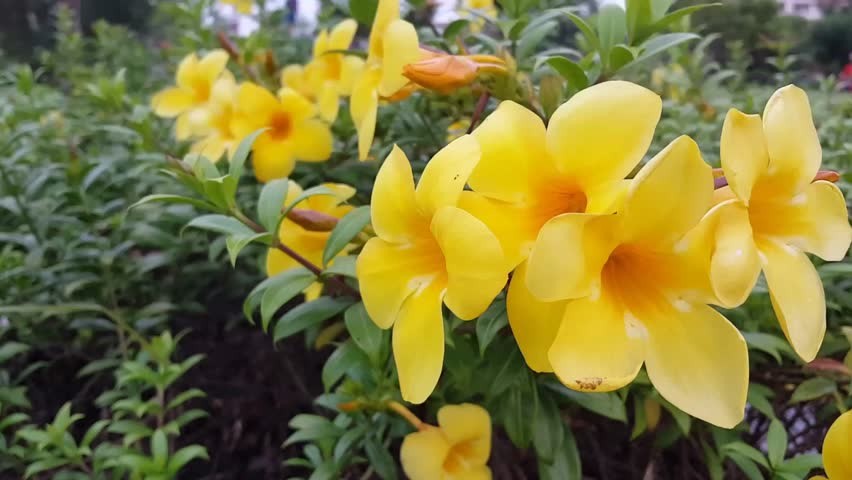Golden Trumpet
(Allamanda schottii)

Description
Allamanda cathartica, commonly called golden trumpet, common trumpetvine, and yellow allamanda, is a species of flowering plant of the genus Allamanda in the family Apocynaceae. It is native to Brazil. This plant is cited in Flora Brasiliensis by Carl Friedrich Philipp von Martius. It does not twine, nor does it have tendrils or aerial roots. It can be pruned into a shrub form. If not pruned it can sprawl to a height of 20 feet. The city of Canóvanas, Puerto Rico has adopted this species, known locally as canario amarillo, as its official flower. The species is cultivated as a house plant. It requires a soil rich in organic matter, temperatures of not less than 18 °C (64 °F) during the growing season, plenty of moisture, and bright light but not direct sunlight. During the rest season from October to March, the plant should be watered more sparingly and can endure temperatures down to 13 °C (55 °F). It should be repotted every year until it is in a container of 40 to 50 centimeters (16 to 20 in). Propagation is by cuttings taken from April to May. Allamanda is a genus of flowering plants in the family Apocynaceae. They are native to the Americas, where they are distributed from Mexico to Argentina. Some species are familiar as ornamental plants cultivated for their large, colorful flowers. Most species produce yellow flowers; A. blanchetii bears pink flowers. The genus name Allamanda honors the Swiss botanist and physician Frédéric-Louis Allamand (1736–1809). It is the official flower of Kuching North City Hall. Plants of the genus are evergreen trees, shrubs, or vines. They contain a white latex. The leaves are opposite or arranged in whorls of up to 5. The blades are generally oval and smooth-edged, and some are leathery or lightly hairy. The inflorescence is a compound cyme. The flower has five lobed sepals and a bell- or funnel-shaped corolla of five petals, yellow in most species. The fruit is a schizocarp containing two to four seeds. In lab analyses Allamanda species have yielded several chemical compounds, including iridoid lactones such as allamandin, plumericin, and plumierides. Plumericin particularly was demonstrated to be a highly potent NF-κB inhibitor with anti-inflammatory activity in vitro and in vivo, while its structurally related derivatives plumierdin, plumeridoid C, and allamandicin did not have activity. The lignan pinoresinol and coumarins such as scopoletin and scoparone have been isolated from A. schottii.
Taxonomic tree:







